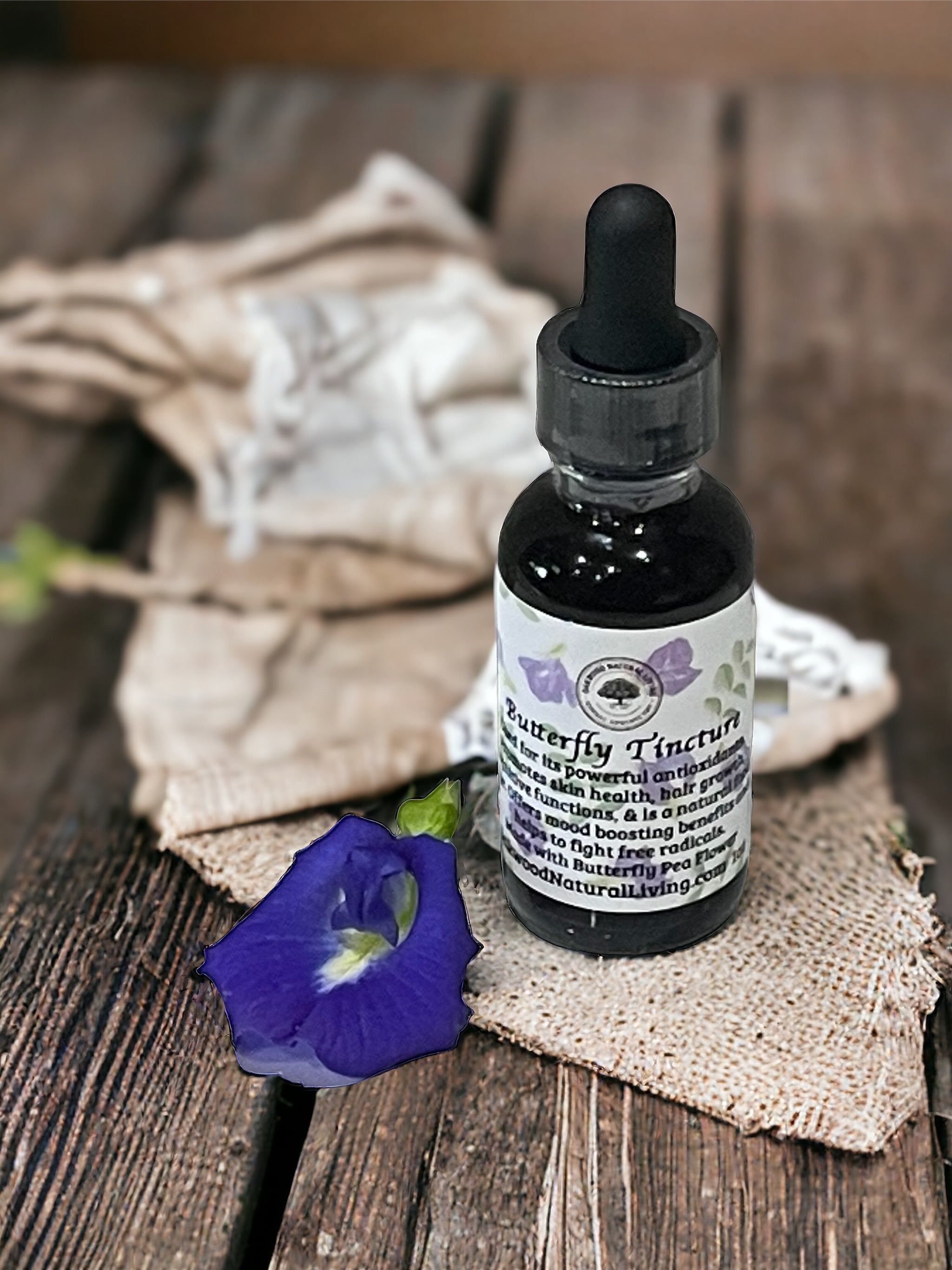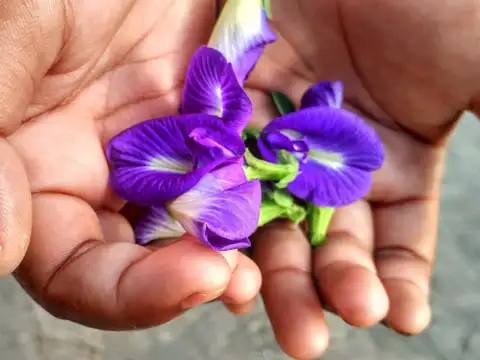Health benefits of butterfly pea flower
What is Butterfly Pea Flower?
Butterfly pea flower, scientifically known as Clitoria ternatea, is a beautiful plant native to tropical equatorial Asia. Renowned for its vibrant blue petals, it's more than just a pretty bloom - it’s also a powerhouse of nutrition and potential health benefits.
The butterfly pea plant is a perennial herb, part of the Fabaceae family. This family also includes other well-known plants like beans, peas, and clovers. The butterfly pea has been an integral part of traditional Asian medicine, especially Ayurveda, for centuries.
Often referred to as 'blue clitoria,' 'butterfly flower,' or 'blue butterfly pea flower,' its unique coloration makes it a popular natural dye in culinary applications across Southeast Asia. The flower's most renowned use, however, is in making the enchanting blue tea.
Nutritional value of Butterfly Pea Flower
- Butterfly pea flowers are rich in antioxidants, including anthocyanins, flavonoids, and phenolic compounds.
- They contain moderate amounts of vitamin C, some vitamin A in the form of carotenoids like beta-carotene, small amounts of iron, and calcium.
- The flowers also provide minimal protein and a small amount of dietary fiber. Additionally, they contain flavonoids like kaempferol and quercetin, along with triterpenoids.

Health Benefits of Butterfly Pea Flower
Butterfly Pea Flower, also known as Clitoria ternatea, is more than just a vibrant blue herb—it’s a powerhouse of natural health benefits. Traditionally used in Ayurvedic and Southeast Asian medicine, Butterfly Pea Flower is gaining global attention for its impressive wellness properties.
From boosting brain function and reducing stress to enhancing skin health and supporting digestion, this herbal flower offers a wide range of benefits backed by both ancient wisdom and modern science.
Here are the top health benefits of Butterfly Pea Flower you should know about:
1. Butterfly Pea Flower Is Rich in Antioxidants
Butterfly pea flower is packed with anthocyanins, the compounds that give it its signature blue color. These antioxidants protect cells from oxidative stress, support skin health, and may slow signs of aging. Daily use can boost immunity and improve overall wellness.
2. Butterfly Pea Flower Supports Brain and Memory Function
Butterfly pea flower is traditionally used to improve mental clarity. Scientific studies suggest it may help enhance memory, focus, and cognitive performance by increasing acetylcholine levels in the brain.
3. Butterfly Pea Flower Helps Reduce Stress and Anxiety
Known for its calming effects, butterfly pea flower tea can help relieve anxiety and promote mental relaxation. It's a natural, caffeine-free way to unwind after a stressful day or before bedtime.
4. Butterfly Pea Flower Has Natural Anti-Inflammatory Properties
Chronic inflammation contributes to many diseases. Butterfly pea flower helps reduce inflammation naturally, making it beneficial for conditions like arthritis, bloating, or general discomfort.
5. Butterfly Pea Flower Improves Skin Health Naturally
Its anti-inflammatory and antioxidant compounds support a clearer, more even-toned complexion. Butterfly pea is also used in natural skincare for its ability to calm redness and promote healthy, glowing skin.
6. Butterfly Pea Flower Promotes Hair Growth and Scalp Health
Flavonoids in butterfly pea flower may stimulate blood flow to the scalp, strengthening hair follicles, and reducing hair thinning. It is often used in herbal hair treatments across Asia.
7. Butterfly Pea Flower May Support Eye Health
Thanks to its anthocyanin content, butterfly pea flower supports retinal health and may reduce eye strain, especially for those exposed to screens daily.
8. Butterfly Pea Flower Helps with Blood Sugar Regulation
Preliminary studies show butterfly pea flower may lower glucose absorption in the body, helping manage blood sugar spikes and supporting diabetes prevention.
9. Butterfly Pea Flower Aids in Digestion and Detox
Traditionally used as a mild diuretic and digestive aid, butterfly pea flower helps with bloating, flushing toxins, and supporting liver function.
10. Butterfly Pea Flower’s Color-Changing Magic
While not a health benefit, its ability to change from blue to purple when mixed with lemon makes it a fun, visual addition to drinks — perfect for wellness smoothies and herbal teas.
11. Butterfly Pea Flower Helps Regulate Blood Sugar Levels
Butterfly Pea Flower may help reduce glucose absorption in the gut, lowering post-meal blood sugar and insulin spikes. It shows potential as a supportive herb for blood sugar management.
12. Butterfly Pea Flower Boosts Brain Function
Butterfly Pea Flower can enhance memory, reduce stress, and improve mood. It supports acetylcholine activity, a neurotransmitter important for cognitive health and reducing symptoms of anxiety or Alzheimer’s.
13. Butterfly Pea Flower Aids in Weight Management
Acting as a natural diuretic and mild laxative, Butterfly Pea Flower supports detoxification, reduces water retention, and may help improve digestion—making it helpful for weight loss efforts.
14. Butterfly Pea Flower Supports Eye Health
Butterfly Pea Flower’s anthocyanins promote better blood flow to the eyes, reduce fatigue, and may protect against retinal damage caused by oxidative stress.
15. Butterfly Pea Flower Improves Respiratory Health
Traditionally used to relieve coughs and colds, Butterfly Pea Flower may reduce inflammation in the airways, helping manage asthma, bronchitis, and seasonal allergies.



How to Enjoy Butterfly Pea Flower: The Best Ways to Consume
Butterfly Pea Flower is not only rich in health benefits but also incredibly easy to add to your daily routine. Whether you prefer sipping herbal tea or experimenting in the kitchen, here are some of the best ways to enjoy this vibrant blue flower:
1. Butterfly Pea Flower Tea
The most popular method is brewing the dried flowers into a soothing herbal tea. Just steep 5–6 dried flowers in hot water for 5–10 minutes. Add lemon juice to see the magical color change from blue to purple.
2. Butterfly Pea Iced Drinks and Lattes
You can blend Butterfly Pea Flower tea with honey, coconut milk, or lime for refreshing iced drinks or colorful lattes. It's a healthy alternative to sugary beverages.
3. Smoothies and Detox Waters
Add brewed Butterfly Pea tea to your smoothies or detox water for a nutritional boost and a splash of color. It pairs well with ingredients like cucumber, mint, and citrus fruits.
4. Baking and Cooking
Use Butterfly Pea Flower powder to color rice, noodles, or baked goods naturally. It’s a fun, chemical-free way to make your dishes visually appealing.
5. Capsules or Powder Supplements
For convenience, Butterfly Pea Flower is available in supplement form. These can be added to your routine if you’re looking for a consistent dose of antioxidants and wellness support.
6. Infused Ice Cubes
Freeze the brewed tea into ice cubes and add them to water, lemonade, or cocktails. As they melt, they release beautiful color and subtle flavor.




Side effects and Precautions of Butterfly Pea Flower
Here are a few side effects of consuming butterfly pea flower:Mild digestive issues: Overconsumption may cause nausea, stomach pain, or diarrhea, though these effects are rare and not strongly supported by research.
Allergic reactions: Some individuals may experience itching, swelling, or trouble breathing. Discontinue use and consult a healthcare provider if allergic symptoms occur.
Pregnancy and breastfeeding: Insufficient research exists on its safety during pregnancy or breastfeeding. It is recommended to avoid it unless advised by a doctor.
Drug interactions: Butterfly pea flower may interact with medications, especially anticoagulants or other herbs. Consult a healthcare provider if on medication.
Toxicity from seeds: The seeds contain oils that can cause vomiting or diarrhea if ingested, particularly in children or individuals with weak immunity.
Excessive consumption: Overconsumption of anthocyanins in the flower may cause adverse reactions. Limit intake to 1–3 cups of tea or 1–2 dried flowers per day.

How to make Butterfly Pea Flower Tea?
Here’s how to make butterfly pea flower tea:Boil water and let it cool slightly to around 200°F (93°C).
Place 1-2 teaspoons of dried butterfly pea flowers in a teapot or mug.
Pour the hot water over the flowers.
Let it steep for 5-10 minutes, depending on how strong you want the color and flavor.
Strain the tea to remove the flowers.
Enjoy the vibrant blue tea as is or add a squeeze of lemon or honey for extra flavor.
Conclusion
The butterfly pea flower, with its attractive appearance and multitude of health benefits, makes it a valuable addition to many diets.
Its antioxidant properties and rich traditional medicinal use highlight its potential as a natural remedy. However, more research is needed to fully understand all of its effects and ensure safe consumption.
Remember, as with any health supplement or dietary change, it's crucial to consult with a healthcare professional before incorporating butterfly pea flower into your routine.
This ensures you reap the butterfly pea flower benefits while avoiding any potential side effects.
References
National Center for Biotechnology Information (NCBI). Butterfly Pea ( Clitoria ternatea ), a Cyclotide-Bearing Plant With Applications in Agriculture and Medicine [Internet]. [cited 2024 Jan 25]. Available from: https://www.ncbi.nlm.nih.gov/pmc/articles/PMC6546959
PubMed. Protective Role of Ternatin Anthocyanins and Quercetin Glycosides from Butterfly Pea (Clitoria ternatea Leguminosae) Blue Flower Petals against Lipopolysaccharide (LPS)-Induced Inflammation in Macrophage Cells [Internet]. [cited 2024 Jan 25]. Available from: https://pubmed.ncbi.nlm.nih.gov/26120869
PubMed. Ternatin and improved synthetic variants kill cancer cells by targeting the elongation factor-1A ternary complex [Internet]. [cited 2024 Jan 25]. Available from: https://pubmed.ncbi.nlm.nih.gov/26651998
National Center for Biotechnology Information (NCBI). Inhibitory effect of Clitoria ternatea flower petal extract on fructose-induced protein glycation and oxidation-dependent damages to albumin in vitro [Internet]. [cited 2024 Jan 25]. Available from: https://www.ncbi.nlm.nih.gov/pmc/articles/PMC4337202
PubMed. Kaempferol: A Key Emphasis to Its Anticancer Potential [Internet]. [cited 2024 Jan 25]. Available from: https://pubmed.ncbi.nlm.nih.gov/31248102
PubMed. p-Coumaric acid and its conjugates: dietary sources, pharmacokinetic properties and biological activities [Internet]. [cited 2024 Jan 25]. Available from: https://pubmed.ncbi.nlm.nih.gov/26692250
PubMed. Anthocyanins, delphinidin-3-O-glucoside and cyanidin-3-O-glucoside, inhibit immune checkpoints in human colorectal cancer cells in vitro and in silico [Internet]. [cited 2024 Jan 25]. Available from: https://pubmed.ncbi.nlm.nih.gov/31399602
National Center for Biotechnology Information (NCBI). Cosmetic and Dermatological Properties of Selected Ayurvedic Plant Extracts [Internet]. [cited 2024 Jan 25]. Available from: https://www.ncbi.nlm.nih.gov/pmc/articles/PMC7866120
PubMed. 5α-reductase inhibition and hair growth promotion of some Thai plants traditionally used for hair treatment [Internet]. [cited 2024 Jan 25]. Available from: https://pubmed.ncbi.nlm.nih.gov/22178180
National Center for Biotechnology Information (NCBI). Antioxidants in dermatology * [Internet]. [cited 2024 Jan 25]. Available from: https://www.ncbi.nlm.nih.gov/pmc/articles/PMC5514576



